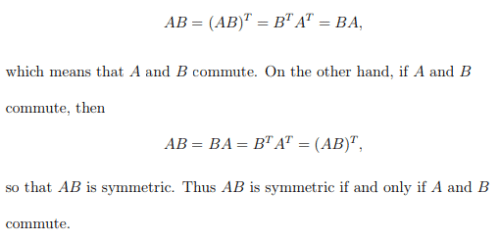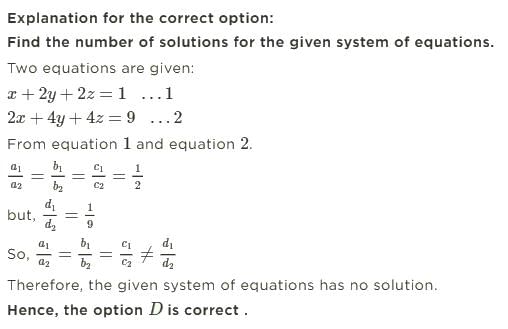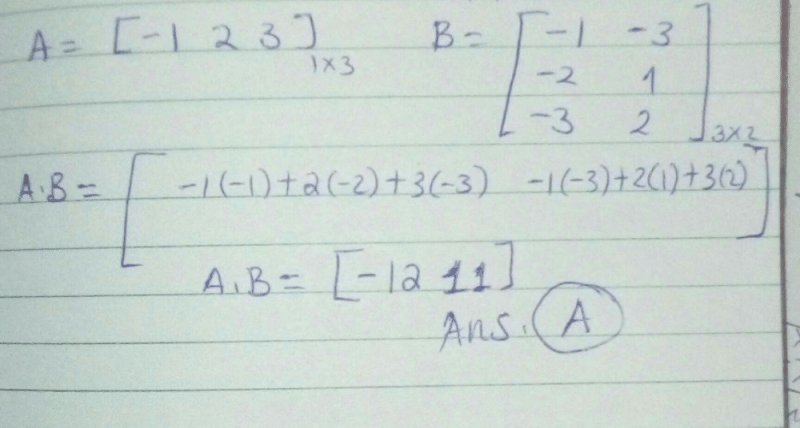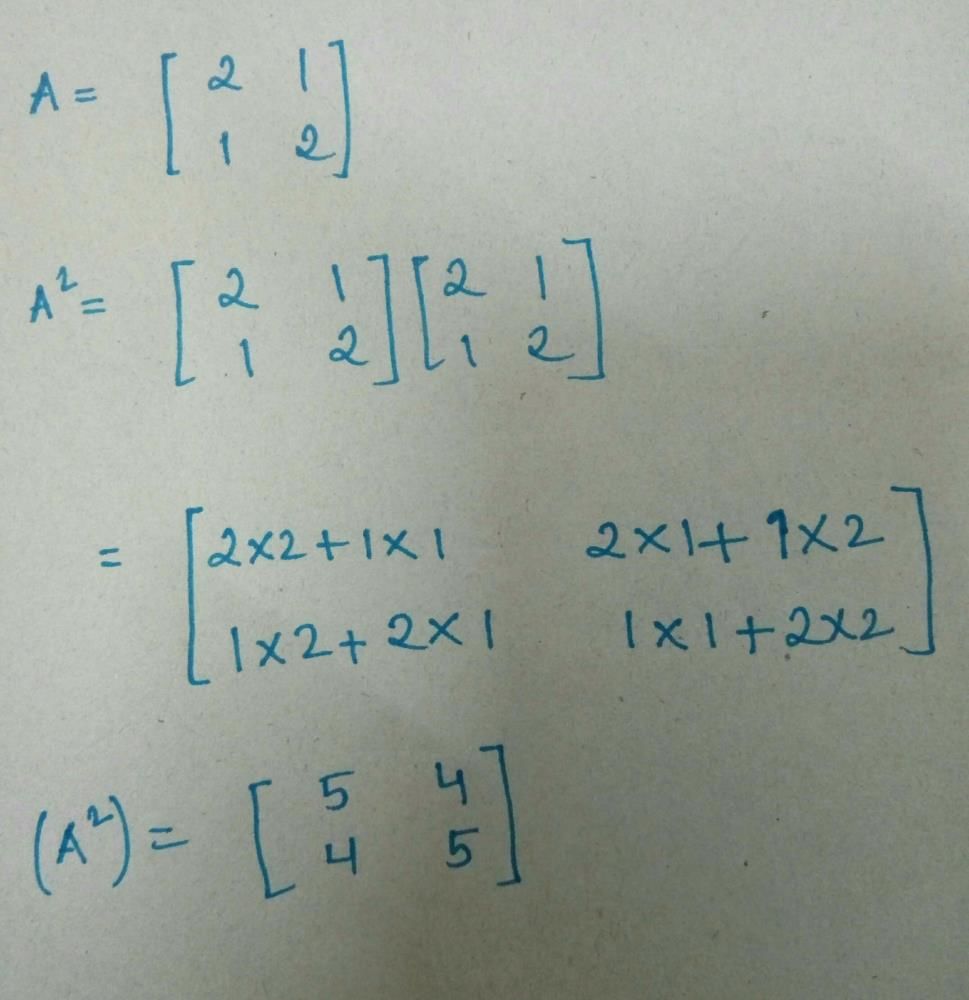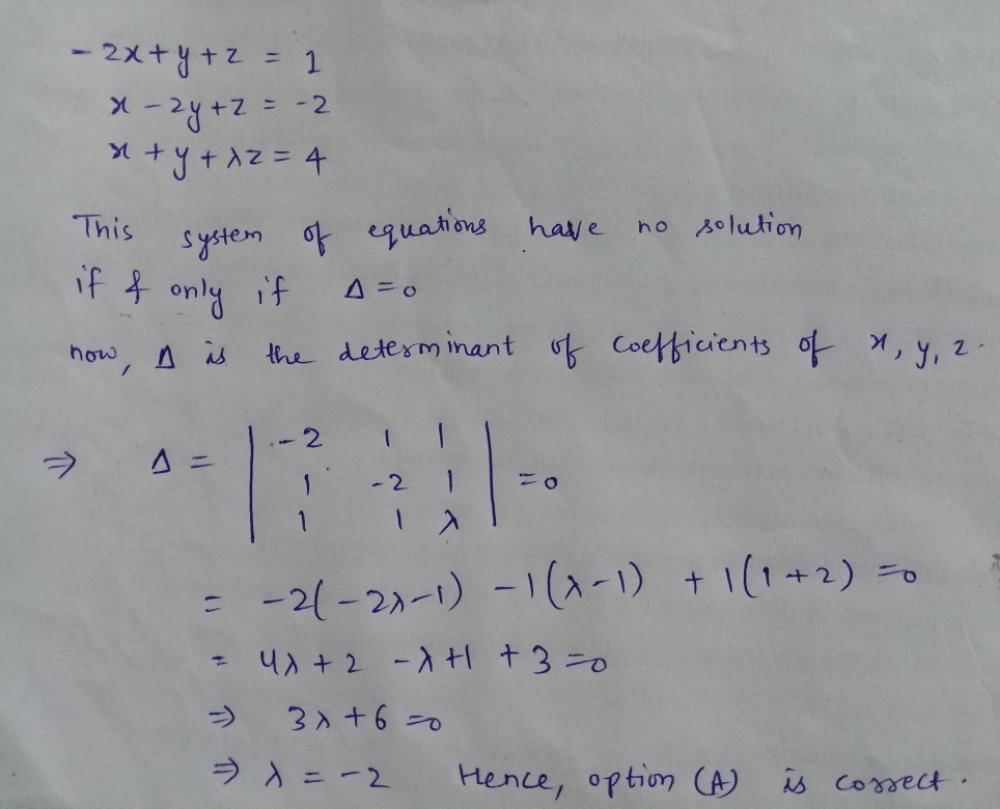All Exams >
JEE >
Chapter-wise Tests for JEE Main & Advanced >
All Questions
All questions of Matrices for JEE Exam
 the value of a22 is
the value of a22 is
- a)0
- b)-2
- c)2
- d)None
Correct answer is option 'C'. Can you explain this answer?
a)
0
b)
-2
c)
2
d)
None

|
Amrit Raj answered |
I=2,j=2
modulus of 2-6=4
4/2=2
hence the correct ans is C :2
If the order of matrix A is m×p. And the order of B is p×n. Then the order of matrix AB is?- a)n × p
- b)m × n
- c)n × p
- d)n × m
Correct answer is option 'D'. Can you explain this answer?
If the order of matrix A is m×p. And the order of B is p×n. Then the order of matrix AB is?
a)
n × p
b)
m × n
c)
n × p
d)
n × m
|
|
Suresh Iyer answered |
If we are given 2 matrices of with order a×b and c×d, in order to be multiplicable, b must be equal to c and the resultant matrix will have order a×d. So using this formula in this question, We have p = p and so the resultant matrix will have m×n order. So, order of matrix AB is m×n.

- a)

- b)

- c)

- d)

Correct answer is option 'D'. Can you explain this answer?
a)
b)
c)
d)

|
Sushil Kumar answered |
P(n) : An = {(1+2n, -4n), (n,(1 - 2n))}
= P(k + 1) = {(1+2(k+1), -4(k+1)), (k+1, (1 - 2(k+1)}
= {(1+2k+2, -4k-4) (k+1, 1-2k-2)}
= {(2k+3, -4k-4), (k+1, -2k-1)}
= P(k + 1) = {(1+2(k+1), -4(k+1)), (k+1, (1 - 2(k+1)}
= {(1+2k+2, -4k-4) (k+1, 1-2k-2)}
= {(2k+3, -4k-4), (k+1, -2k-1)}
 Then the value of x is ____
Then the value of x is ____- a)6
- b)3
- c)2
- d)0
Correct answer is option 'B'. Can you explain this answer?
a)
6
b)
3
c)
2
d)
0
|
|
Geetika Shah answered |

= x+10 = 3x+4
= x = 3
 is example of
is example of- a)an identity matrix
- b)a zero matrix.
- c)a Scalar m
- d)diagonal matrix.
Correct answer is option 'D'. Can you explain this answer?
a)
an identity matrix
b)
a zero matrix.
c)
a Scalar m
d)
diagonal matrix.

|
Divey Sethi answered |
A matrix having non-zero elements only in the diagonal running from the upper left to the lower right.
The given matrix is a diagonal matrix.
If a matrix B is obtained from matrix A by an elementary row or column transformation then B is said to be ______ of A- a)Equivalent
- b)Inverse
- c)Adjoint
- d)none of the above
Correct answer is option 'A'. Can you explain this answer?
If a matrix B is obtained from matrix A by an elementary row or column transformation then B is said to be ______ of A
a)
Equivalent
b)
Inverse
c)
Adjoint
d)
none of the above
|
|
Rajesh Gupta answered |
ANSWER :- a
Solution :- Matrix equivalence is an equivalence relation on the space of rectangular matrices.
For two rectangular matrices of the same size, their equivalence can also be characterized by the following conditions
- The matrices can be transformed into one another by a combination of elementary row and column operations.
If a matrix B is obtained from matrix A by an elementary row or column transformation then B is said to be equivalent of A.
The system of the linear equations x + y – z = 6, x + 2y – 3z = 14 and 2x + 5y – λz = 9 (λ ∈ R) has a unique solution if- a)λ = -8
- b)λ = 8
- c)λ = -7
- d)λ = 7
Correct answer is option 'B'. Can you explain this answer?
The system of the linear equations x + y – z = 6, x + 2y – 3z = 14 and 2x + 5y – λz = 9 (λ ∈ R) has a unique solution if
a)
λ = -8
b)
λ = 8
c)
λ = -7
d)
λ = 7

|
Divey Sethi answered |
For a system of linear equations having unique solution, value of the determinant should not be 0
⇒ {(1,1,-1) (1,2,-3) (2,5,-λ)} not equal to o
⇒ [−2λ+15−1(−λ+6)−(5−4)] ≠ 0
⇒ −λ+8 ≠ 0
⇒ λ ≠ 8
⇒ {(1,1,-1) (1,2,-3) (2,5,-λ)} not equal to o
⇒ [−2λ+15−1(−λ+6)−(5−4)] ≠ 0
⇒ −λ+8 ≠ 0
⇒ λ ≠ 8
The inverse of  is
is- a)

- b)

- c)

- d)

Correct answer is option 'B'. Can you explain this answer?
The inverse of  is
is
a)
b)
c)
d)

|
Adarsh Gupta answered |
A11=0A12=1A21=1A22=0A^-1=[01] [10]
Which of the following is a nilpotent matrix- a)

- b)

- c)

- d)

Correct answer is option 'C'. Can you explain this answer?
Which of the following is a nilpotent matrix
a)
b)
c)
d)

|
Sushil Kumar answered |
An n×n matrix A is called nilpotent if Ak=O, where O is the n×n zero matrix.
(a) The matrix A is nilpotent if and only if all the eigenvalues of A is zero.
(b) The matrix A is nilpotent if and only if An=O.
Therefore, option c gives zero matrix.
(a) The matrix A is nilpotent if and only if all the eigenvalues of A is zero.
(b) The matrix A is nilpotent if and only if An=O.
Therefore, option c gives zero matrix.
If  and
and  , then AB=?
, then AB=?- a)[7]
- b)[1 - 12]
- c)

- d)[18]
Correct answer is option 'A'. Can you explain this answer?
If  and
and  , then AB=?
, then AB=?
a)
[7]
b)
[1 - 12]
c)
d)
[18]
|
|
Ritu Singh answered |
A = [2, 3, 4]
 Therefore AXB = {(2*1) + (3*(-1)) + (4*2)}
Therefore AXB = {(2*1) + (3*(-1)) + (4*2)}
AXB = {2 + (-3) + 8}
AXB = 7
 Therefore AXB = {(2*1) + (3*(-1)) + (4*2)}
Therefore AXB = {(2*1) + (3*(-1)) + (4*2)}AXB = {2 + (-3) + 8}
AXB = 7
 then x is equal to
then x is equal to- a) –1
- b)2
- c)1
- d)No value of x
Correct answer is option 'A'. Can you explain this answer?
a)
–1
b)
2
c)
1
d)
No value of x

|
Sonålí Raåz answered |
If u solve this matrix by addition of matrix then u get x^2+ x. x-1 -x +4. x +2 matrix which is equal to matrix. 0. -2 5. 1 ..........so now by equality of matrix , equalte any of four equation with the corresponding element of second matrix ....i.e, (-x +4)= 5 which gives the value of x equal to -1 ...Ans.
If A, B are symmetric matrices of same order then the matrix AB-BA is a- a)Skew-symmetric matrix
- b)Skew-Harmitian matrix
- c)Symmetric matrix
- d)Harmitian matrix
Correct answer is option 'A'. Can you explain this answer?
If A, B are symmetric matrices of same order then the matrix AB-BA is a
a)
Skew-symmetric matrix
b)
Skew-Harmitian matrix
c)
Symmetric matrix
d)
Harmitian matrix

|
Sushil Kumar answered |
A and B are symmetric matrices, therefore, we have:
A′=A and B′=B..........(i)
Consider
(AB−BA)′=(AB)′ − (BA)′,[∵(A−B)′=A′B′]
=B′A′− A′B',[∵(AB)′= B′A]
=BA−AB [by (i) ]
=−(AB−BA)
∴(AB−BA) ′=−(AB−BA)
Thus, (AB−BA) is a skew-symmetric matrix.
A′=A and B′=B..........(i)
Consider
(AB−BA)′=(AB)′ − (BA)′,[∵(A−B)′=A′B′]
=B′A′− A′B',[∵(AB)′= B′A]
=BA−AB [by (i) ]
=−(AB−BA)
∴(AB−BA) ′=−(AB−BA)
Thus, (AB−BA) is a skew-symmetric matrix.
The number of all possible matrices of order 3×3 with each entry 0 if 1 is- a)81
- b)512
- c)18
- d)none of these
Correct answer is option 'B'. Can you explain this answer?
The number of all possible matrices of order 3×3 with each entry 0 if 1 is
a)
81
b)
512
c)
18
d)
none of these
|
|
Harsh Majumdar answered |
To find the number of all possible matrices of order 3, we need to consider the number of choices for each entry in the matrix.
In a matrix of order 3, there are 9 entries. Each entry can be chosen from any number in the set {0, 1, 2, ..., 9} since there are no restrictions mentioned. Therefore, there are 10 choices for each entry.
Since each entry can be chosen independently, we can use the multiplication principle to find the total number of matrices. This principle states that if there are n choices for one event and m choices for another event, then there are n * m choices for both events together.
Applying this principle to our matrix, we have 10 choices for each of the 9 entries. Therefore, the total number of possible matrices of order 3 is 10^9.
Hence, the number of all possible matrices of order 3 is 10^9.
In a matrix of order 3, there are 9 entries. Each entry can be chosen from any number in the set {0, 1, 2, ..., 9} since there are no restrictions mentioned. Therefore, there are 10 choices for each entry.
Since each entry can be chosen independently, we can use the multiplication principle to find the total number of matrices. This principle states that if there are n choices for one event and m choices for another event, then there are n * m choices for both events together.
Applying this principle to our matrix, we have 10 choices for each of the 9 entries. Therefore, the total number of possible matrices of order 3 is 10^9.
Hence, the number of all possible matrices of order 3 is 10^9.
If  , then
, then  is equal to
is equal to - a)

- b)

- c)

- d)

Correct answer is option 'D'. Can you explain this answer?
If  , then
, then  is equal to
is equal to
a)
b)
c)
d)
|
|
Geetika Shah answered |
A’ = {(1,-1,5) (0,0,2)} B = {(-2,0) (0,2) (3,4)}
B’ = {(-2,0,3) (0,2,4)}
2B’ = 2{(-2,0,3) (0,2,4)}
2B’ = {(-4,0,6) (0,4,8)}
(A’ - 2B’) = {(1,-1,5) (0,0,2)} - {(-4,0,6) (0,4,8)}
= {(5,-1,-1) (0,-4,-6)}
(A’ - 2B’)’ = {(5,0) (-1,-4) (-1,-6)}
B’ = {(-2,0,3) (0,2,4)}
2B’ = 2{(-2,0,3) (0,2,4)}
2B’ = {(-4,0,6) (0,4,8)}
(A’ - 2B’) = {(1,-1,5) (0,0,2)} - {(-4,0,6) (0,4,8)}
= {(5,-1,-1) (0,-4,-6)}
(A’ - 2B’)’ = {(5,0) (-1,-4) (-1,-6)}
The value of λ, for which system of equations. x + y + z = 1, x + 2y + 2z = 3, x + 2y + λz = 4, have no solution is
- a)1
- b)2
- c)0
- d)3
Correct answer is option 'B'. Can you explain this answer?
The value of λ, for which system of equations. x + y + z = 1, x + 2y + 2z = 3, x + 2y + λz = 4, have no solution is
a)
1
b)
2
c)
0
d)
3
|
|
Kiran Sengupta answered |
This question is unclear as there is no context or information provided. Please provide more details for me to give a relevant answer.
Consider the following information regarding the number of men and women workers in three BPOs I, II and III What does the entry in the second row and first column represent if the information is represented as a 3 x 2 matrix?
What does the entry in the second row and first column represent if the information is represented as a 3 x 2 matrix?- a)The number of Men in BPO II
- b)The number of Women in BPO II
- c)The number of Women in BPO I
- d)The number of Men in BPO I
Correct answer is 'A'. Can you explain this answer?
Consider the following information regarding the number of men and women workers in three BPOs I, II and III
What does the entry in the second row and first column represent if the information is represented as a 3 x 2 matrix?
a)
The number of Men in BPO II
b)
The number of Women in BPO II
c)
The number of Women in BPO I
d)
The number of Men in BPO I
|
|
Sanjeevini Angadi answered |
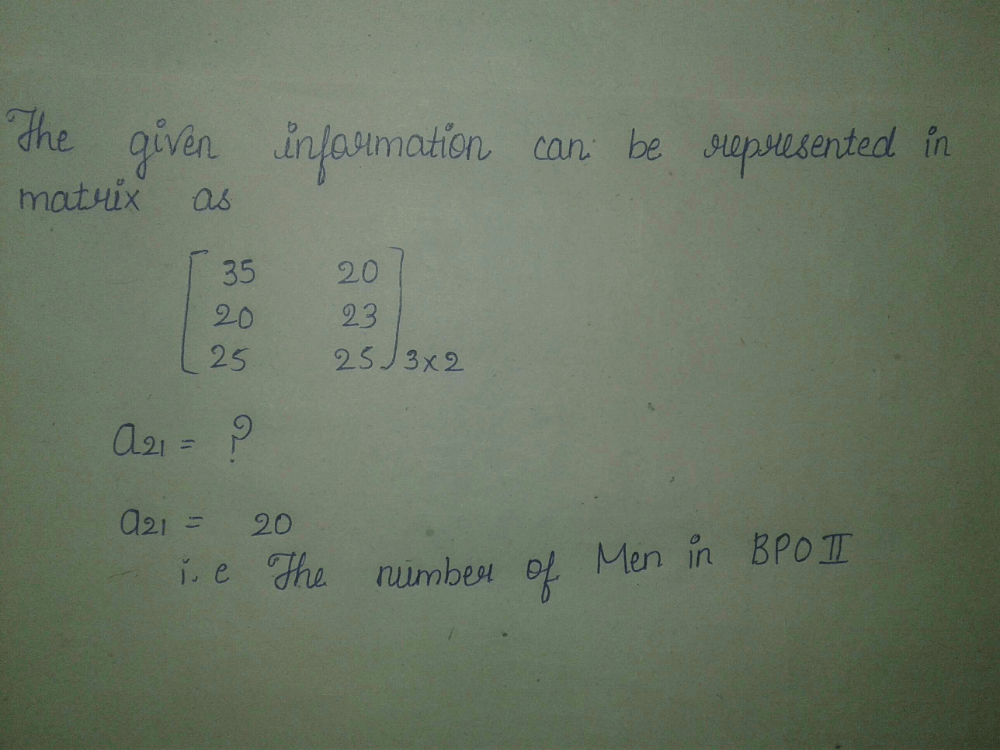
For a skew symmetric even ordered matrix A of integers, which of the following will not hold true:
- a)det(A) = 9
- b)det(A) = 81
- c)det(A) = 7
- d)det(A) = 4
Correct answer is option 'C'. Can you explain this answer?
For a skew symmetric even ordered matrix A of integers, which of the following will not hold true:
a)
det(A) = 9
b)
det(A) = 81
c)
det(A) = 7
d)
det(A) = 4
|
|
Aniket Dasgupta answered |
Skew Symmetric Even Ordered Matrix and Determinant
Skew Symmetric Matrix:
A skew symmetric matrix is a square matrix whose transpose is equal to its negative. In other words, if A is a skew symmetric matrix, then A^T = -A.
Example:
[0 -3 4]
[3 0 -5]
[-4 5 0]
This is a 3x3 skew symmetric matrix because A^T = -A.
Even Ordered Matrix:
An even ordered matrix is a square matrix whose order is even. In other words, if A is an even ordered matrix, then the order of A is 2n, where n is a positive integer.
Example:
[2 1 5 3]
[4 6 8 2]
[9 7 1 5]
[3 4 2 6]
This is a 4x4 even ordered matrix because the order of A is 2n=4.
Determinant of a Skew Symmetric Even Ordered Matrix:
The determinant of a skew symmetric even ordered matrix is always equal to zero. This is because the determinant of a skew symmetric matrix of odd order is always equal to zero and the determinant of any even ordered matrix can be expressed as a sum of permutations of the determinants of its n x n submatrices. Since the submatrices of a skew symmetric matrix are also skew symmetric, their determinants are equal to zero. Therefore, the determinant of a skew symmetric even ordered matrix is also equal to zero.
Solution:
a) det(A) = 9
Since the determinant of a skew symmetric even ordered matrix is always equal to zero, this statement is false. Therefore, option 'a' is not true.
b) det(A) = 81
Since the determinant of a skew symmetric even ordered matrix is always equal to zero, this statement is false. Therefore, option 'b' is not true.
c) det(A) = 7
This statement is false because the determinant of a skew symmetric even ordered matrix is always equal to zero.
d) det(A) = 4
Since the determinant of a skew symmetric even ordered matrix is always equal to zero, this statement is false. Therefore, option 'd' is not true.
Therefore, the correct answer is option 'c'.
Skew Symmetric Matrix:
A skew symmetric matrix is a square matrix whose transpose is equal to its negative. In other words, if A is a skew symmetric matrix, then A^T = -A.
Example:
[0 -3 4]
[3 0 -5]
[-4 5 0]
This is a 3x3 skew symmetric matrix because A^T = -A.
Even Ordered Matrix:
An even ordered matrix is a square matrix whose order is even. In other words, if A is an even ordered matrix, then the order of A is 2n, where n is a positive integer.
Example:
[2 1 5 3]
[4 6 8 2]
[9 7 1 5]
[3 4 2 6]
This is a 4x4 even ordered matrix because the order of A is 2n=4.
Determinant of a Skew Symmetric Even Ordered Matrix:
The determinant of a skew symmetric even ordered matrix is always equal to zero. This is because the determinant of a skew symmetric matrix of odd order is always equal to zero and the determinant of any even ordered matrix can be expressed as a sum of permutations of the determinants of its n x n submatrices. Since the submatrices of a skew symmetric matrix are also skew symmetric, their determinants are equal to zero. Therefore, the determinant of a skew symmetric even ordered matrix is also equal to zero.
Solution:
a) det(A) = 9
Since the determinant of a skew symmetric even ordered matrix is always equal to zero, this statement is false. Therefore, option 'a' is not true.
b) det(A) = 81
Since the determinant of a skew symmetric even ordered matrix is always equal to zero, this statement is false. Therefore, option 'b' is not true.
c) det(A) = 7
This statement is false because the determinant of a skew symmetric even ordered matrix is always equal to zero.
d) det(A) = 4
Since the determinant of a skew symmetric even ordered matrix is always equal to zero, this statement is false. Therefore, option 'd' is not true.
Therefore, the correct answer is option 'c'.
The inverse of  is
is- a)

- b)

- c)

- d)

Correct answer is option 'B'. Can you explain this answer?
The inverse of  is
is
a)
b)
c)
d)
|
|
Hansa Sharma answered |
A = IA
AA-1 = I
A = {(1,0),(-1,1)}
A-1{(1,0),(-1,1)} = {(1,0),(0,1)}
R2 ----> R2 + R1
A^-1 {(1,0),(0,1)} = {(1,0),(1,1)}
I A-1 = {(1,0),(1,1)}
Therefore, A-1 = {(1,0),(1,1)}
AA-1 = I
A = {(1,0),(-1,1)}
A-1{(1,0),(-1,1)} = {(1,0),(0,1)}
R2 ----> R2 + R1
A^-1 {(1,0),(0,1)} = {(1,0),(1,1)}
I A-1 = {(1,0),(1,1)}
Therefore, A-1 = {(1,0),(1,1)}
The product of two matrics 
- a)

- b)

- c)

- d)

Correct answer is option 'B'. Can you explain this answer?
The product of two matrics 
a)
b)
c)
d)

|
Sushil Kumar answered |
{(1*0, 2*2, 0*x) (2*0, 0*2, 1*x) (1*0, 0*2, 2*x)}
= {4, x, 2x}
= {4, x, 2x}
The number of different orders of a matrix having 12 elements is- a)3
- b)1
- c)6
- d)None of these
Correct answer is option 'C'. Can you explain this answer?
The number of different orders of a matrix having 12 elements is
a)
3
b)
1
c)
6
d)
None of these
|
|
Nandini Iyer answered |
(1,12),(2,6),(3,4(,(4,3),(6,2),(12,1)
6 different matrices.
6 different matrices.
If A is square matrix of order 3, then the true statement is (where l is unit matrix).- a) Det (–A) = –det A
- b) Det A = 0
- c) Det (A + l) = 1 + det A
- d)Det 2A = 2 det A
Correct answer is option 'A'. Can you explain this answer?
If A is square matrix of order 3, then the true statement is (where l is unit matrix).
a)
Det (–A) = –det A
b)
Det A = 0
c)
Det (A + l) = 1 + det A
d)
Det 2A = 2 det A
|
|
Deepak Kumar answered |
A+l)=Det(A)+Det(l)
This statement is false.
The correct statement is: Det(A+l) = 1 + tr(A) + tr(A)^2, where tr(A) is the trace of matrix A (i.e. the sum of its diagonal elements).
This statement is false.
The correct statement is: Det(A+l) = 1 + tr(A) + tr(A)^2, where tr(A) is the trace of matrix A (i.e. the sum of its diagonal elements).
If  and
and  then
then  is equal to
is equal to- a)

- b)

- c)

- d)

Correct answer is option 'B'. Can you explain this answer?
If  and
and  then
then  is equal to
is equal to
a)
b)
c)
d)

|
Sakshi Dagar answered |
Hey multiply A by B . Then you easily get answer
 , then (AB)` is equal to
, then (AB)` is equal to- a)

- b)

- c)

- d)

Correct answer is option 'A'. Can you explain this answer?
a)
b)
c)
d)
|
|
Vikas Kapoor answered |
A ={(1,2) (4,3)} B = {(3,2) (-1,1)}
AB= {[(1*3)+(2*(-1)) (1*2)+(2*1)] [(4*3)+(3 *(-1)) (4*2)+(3*1)]}
= {(1,4) (9,11)}
AB= {[(1*3)+(2*(-1)) (1*2)+(2*1)] [(4*3)+(3 *(-1)) (4*2)+(3*1)]}
= {(1,4) (9,11)}
If A and B are two matrices conformable to multiplication such that their product AB = O(Zero matrix). Then which of the following can be true
- a)A and B are both null matrices
- b)Either of A is or B is a null matrix
- c)Either of them may be a zero matrix
- d)It is Not necessary that A = 0 or B = 0
Correct answer is option 'D'. Can you explain this answer?
If A and B are two matrices conformable to multiplication such that their product AB = O(Zero matrix). Then which of the following can be true
a)
A and B are both null matrices
b)
Either of A is or B is a null matrix
c)
Either of them may be a zero matrix
d)
It is Not necessary that A = 0 or B = 0
|
|
Gaurav Kumar answered |
AB = 0 does not necessarily imply that either A or B is a null matrix
- Both matrices need not be null matrices.
- Both matrices need not be null matrices.
For a skew symmetric odd ordered matrix A of integers, which of the following will hold true:- a)det(A) = 9
- b)det(A) = 81
- c)det(A) = 0
- d)et(A) = 4
Correct answer is option 'C'. Can you explain this answer?
For a skew symmetric odd ordered matrix A of integers, which of the following will hold true:
a)
det(A) = 9
b)
det(A) = 81
c)
det(A) = 0
d)
et(A) = 4
|
|
Raghav Bansal answered |
Determinant of a skew symmetric odd ordered matrix A is always 0 .
If A and B are square matrices of the same order, then(A+B)2 = A2+2AB+B2 implies- a)AB + BA = O
- b)AB = O
- c)AB = BA
- d)none of these.
Correct answer is 'A'. Can you explain this answer?
If A and B are square matrices of the same order, then(A+B)2 = A2+2AB+B2 implies
a)
AB + BA = O
b)
AB = O
c)
AB = BA
d)
none of these.

|
Samridhi Bajaj answered |
If A and B are square matrices of same order , then , product of the matrices is not commutative.Therefore , the given result is true only when AB = BA.
 the value of a22 is
the value of a22 is- a)0
- b)-2
- c)2
- d)4
Correct answer is 'D'. Can you explain this answer?
a)
0
b)
-2
c)
2
d)
4

|
Arpita Nair answered |
aij = 1/2 |i-3j|
As aij = a22 ie i = 2 and j = 2
By substituting the values in the equation, we get
a22 = 1/2 |2-3(2)| = 1/2 |-4| = 2
As aij = a22 ie i = 2 and j = 2
By substituting the values in the equation, we get
a22 = 1/2 |2-3(2)| = 1/2 |-4| = 2
The number of all possible matrices of order 3×3 with each entry 0 or 1 is- a)18
- b)81
- c)512
- d)none of these
Correct answer is option 'C'. Can you explain this answer?
The number of all possible matrices of order 3×3 with each entry 0 or 1 is
a)
18
b)
81
c)
512
d)
none of these
|
|
Nandini Patel answered |
A matrix of order 3 x 3 has 9 elements. Now each element can be 0 or 1.
∴ 9 places can be filled up in 2^9 ways
required number of matrices = 2^9
=2 x 2 x 2 x 2 x 2 x 2 x 2 x 2 x 2
=512
The inverse of a matrix is defined for- a)Only square matrices
- b)Diagonal matrices
- c)all matrices
- d)Rectangular matrices
Correct answer is option 'A'. Can you explain this answer?
The inverse of a matrix is defined for
a)
Only square matrices
b)
Diagonal matrices
c)
all matrices
d)
Rectangular matrices

|
Sushil Kumar answered |
The inverse exists only for square matrix. However this is not true. A nonsingular matrix must have their inverse whether it is square or nonsquare matrix.
If the order of the matrix is m×n, then how many elements will there be in the matrix?- a)mn
- b)m2 n2
- c)mn2
- d)2mn
Correct answer is option 'A'. Can you explain this answer?
If the order of the matrix is m×n, then how many elements will there be in the matrix?
a)
mn
b)
m2 n2
c)
mn2
d)
2mn
|
|
Neha Sharma answered |
The number of elements for a matrix with the order m×n is equal to mn, where m is the number of rows and n is the number of columns in the matrix.
If A is a square matrix such that A2 =  then A–1 equal to
then A–1 equal to- a)2A
- b)A
- c)O
- d)A + I
Correct answer is option 'B'. Can you explain this answer?
If A is a square matrix such that A2 =  then A–1 equal to
then A–1 equal to
a)
2A
b)
A
c)
O
d)
A + I

|
Infinity Academy answered |
As we know that, A2 = I
On multiplying both sides by A-1
(A2)A-1 = I A-1
A = I A-1
A = A-1
On multiplying both sides by A-1
(A2)A-1 = I A-1
A = I A-1
A = A-1
Which of the following property of matrix multiplication is correct:- a)Multiplication is not commutative in genral
- b)Multiplication is associative
- c)Multiplication is distributive over addition
- d)All of the mentioned
Correct answer is option 'D'. Can you explain this answer?
Which of the following property of matrix multiplication is correct:
a)
Multiplication is not commutative in genral
b)
Multiplication is associative
c)
Multiplication is distributive over addition
d)
All of the mentioned

|
Prasenjit Dasgupta answered |
Matrix multiplication is associative, distributive, but not commutative.
If A is a matrix of order 1×3 and B is a matrix of order 3×4, then order of the matrix obtained on multiplying A and B is- a)3×3
- b)4×1
- c)3×4
- d)1×4
Correct answer is option 'D'. Can you explain this answer?
If A is a matrix of order 1×3 and B is a matrix of order 3×4, then order of the matrix obtained on multiplying A and B is
a)
3×3
b)
4×1
c)
3×4
d)
1×4
|
|
Nandini Iyer answered |
In matrix 1*3 is one row and 3 columns and in 3*4 is three rows and four column hence multiplied matrix will be 1*4.
A square matrix A = [aij]n×n is called a diagonal matrix if aij = 0 for- a)I < j
- b)I = j
- c)I > j
- d)I ≠ j
Correct answer is option 'D'. Can you explain this answer?
A square matrix A = [aij]n×n is called a diagonal matrix if aij = 0 for
a)
I < j
b)
I = j
c)
I > j
d)
I ≠ j

|
Dr Manju Sen answered |
In a diagonal matrix all elements except diagonal elements are zero.i.e.

What is the element in the 2nd row and 1st column of a 2 x 2 Matrix A = [ aij], such that a = (i + 3) (j – 1)- a)0
- b)4
- c)-5
- d)5
Correct answer is 'A'. Can you explain this answer?
What is the element in the 2nd row and 1st column of a 2 x 2 Matrix A = [ aij], such that a = (i + 3) (j – 1)
a)
0
b)
4
c)
-5
d)
5
|
|
Nishanth Joshi answered |
The element in the 2nd row and 1st column of the matrix A can be found by substituting i=2 and j=1 into the expression a = (i 3) (j 2) and simplifying:
a = (2 - 3) (1 - 2) = (-1) (-1) = 1
Therefore, the element in the 2nd row and 1st column of the matrix A is 1.
a = (2 - 3) (1 - 2) = (-1) (-1) = 1
Therefore, the element in the 2nd row and 1st column of the matrix A is 1.
Consider the set A of all determinants of order 3 with entries 0 or 1 only. Let B be the subset of A consisting of all determinants with value 1. Let C be the subset of A consisting of all determinants with value –1. Then
- a)C is empty
- b)B has as many elements as C
- c)A = B∪C
- d)B has twice as many elements as elements as C
Correct answer is option 'B'. Can you explain this answer?
Consider the set A of all determinants of order 3 with entries 0 or 1 only. Let B be the subset of A consisting of all determinants with value 1. Let C be the subset of A consisting of all determinants with value –1. Then
a)
C is empty
b)
B has as many elements as C
c)
A = B∪C
d)
B has twice as many elements as elements as C
|
|
Lekshmi Choudhury answered |
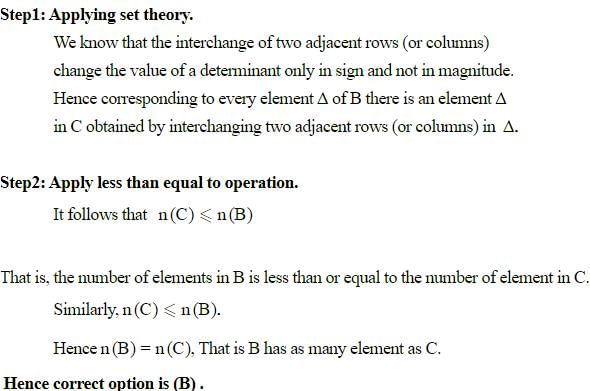
If  satisfies the equation x2 – (a + d) x + k = 0, then
satisfies the equation x2 – (a + d) x + k = 0, then- a)k = bc
- b)k = ad
- c)k = a2 + b2 + c2 + d2
- d)ad – bc
Correct answer is option 'D'. Can you explain this answer?
If  satisfies the equation x2 – (a + d) x + k = 0, then
satisfies the equation x2 – (a + d) x + k = 0, then
 satisfies the equation x2 – (a + d) x + k = 0, then
satisfies the equation x2 – (a + d) x + k = 0, thena)
k = bc
b)
k = ad
c)
k = a2 + b2 + c2 + d2
d)
ad – bc

|
Knowledge Hub answered |
Let λI = {(a,b) (c,d)}
{(λ,0) (0,λ)} - {(a,b) (c,d)}
= {(λ-a,0) (0,λ-d)} = 0
A = {(λ-a,b) (c,λ-d)}
= λ2 - (a+d)λ + (ad+bc)
= A2 - (a+d)A + (ad+bc)
⇒ k = ad - bc
{(λ,0) (0,λ)} - {(a,b) (c,d)}
= {(λ-a,0) (0,λ-d)} = 0
A = {(λ-a,b) (c,λ-d)}
= λ2 - (a+d)λ + (ad+bc)
= A2 - (a+d)A + (ad+bc)
⇒ k = ad - bc
If A is a non–singular matrix and AT denotes the transpose of A, then- a)|A| ≌ |AT|
- b)|A . AT| ≌ |A|2
- c) |AT . A| ≌ |AT|2
- d)|A| + |AT| ≌ 0
Correct answer is option 'D'. Can you explain this answer?
If A is a non–singular matrix and AT denotes the transpose of A, then
a)
|A| ≌ |AT|
b)
|A . AT| ≌ |A|2
c)
|AT . A| ≌ |AT|2
d)
|A| + |AT| ≌ 0
|
|
Krish Kapoor answered |
As we know that, |A| is not equal to zero
|A’| is also not equal to zero
So |A| + |A’| will not be equal to zero. Hence option d is correct.
|A’| is also not equal to zero
So |A| + |A’| will not be equal to zero. Hence option d is correct.
Rank of a non-zero matrix is always- a)⩾1
- b)0
- c)greater than 1
- d)equal to 1
Correct answer is option 'A'. Can you explain this answer?
Rank of a non-zero matrix is always
a)
⩾1
b)
0
c)
greater than 1
d)
equal to 1
|
|
Om Desai answered |
Rank of a non zero matrix is always greater than or equal to 1.
Chapter doubts & questions for Matrices - Chapter-wise Tests for JEE Main & Advanced 2025 is part of JEE exam preparation. The chapters have been prepared according to the JEE exam syllabus. The Chapter doubts & questions, notes, tests & MCQs are made for JEE 2025 Exam. Find important definitions, questions, notes, meanings, examples, exercises, MCQs and online tests here.
Chapter doubts & questions of Matrices - Chapter-wise Tests for JEE Main & Advanced in English & Hindi are available as part of JEE exam.
Download more important topics, notes, lectures and mock test series for JEE Exam by signing up for free.

Contact Support
Our team is online on weekdays between 10 AM - 7 PM
Typical reply within 3 hours
|
Free Exam Preparation
at your Fingertips!
Access Free Study Material - Test Series, Structured Courses, Free Videos & Study Notes and Prepare for Your Exam With Ease

 Join the 10M+ students on EduRev
Join the 10M+ students on EduRev
|

|
Create your account for free
OR
Forgot Password
OR
Signup to see your scores
go up
within 7 days!
within 7 days!
Takes less than 10 seconds to signup



